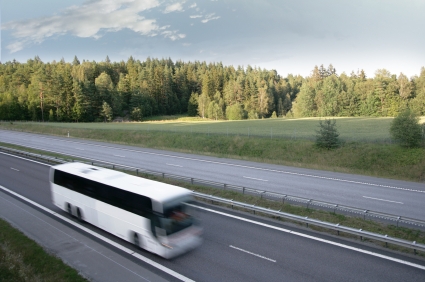
Bus travel, the ugly stepchild of intercity transportation, may be making a bit of a comeback in the U.S. What with high airfares everywhere on one hand, and no foreseeable expansion of Amtrak on the other, buses are likely to be the transport of last resort for the cash-strapped. A reader recently asked about a very specific bus itinerary:
“I need to get to Toronto from the Buffalo airport. There must be some transportation, but I can’t find it. What can I do?”
The short answer is that a relative newcomer to our shores, Megabus, runs once daily between Buffalo airport and downtown Toronto.
But this reader’s specific question raises the broader issue of the new intercity bus services that are starting to operate. Here’s a brief summary.
Why a Bus?
Until recently, bus travel has been the province mainly of the very low end of the travel marketplace. But with airfares climbing, the combination of price, the frustrations of airport security, and crummy service in coach class air travel may lead travelers to rethink their choices. On trips of 300 miles or less, a bus may start to look competitive.
In Europe, of course, high-speed trains are taking over the short-haul intercity market. But here, Amtrak covers only a small portion of the intercity market, with no significant expansions in sight. And on most routes, express buses can keep up with—or even beat—Amtrak schedules.
Greyhound: The Old Standby
Greyhound has been around a long time, and it has taken over most of the nation’s intercity bus service, either on its own or in partnership with local companies. For much of the last three decades, low-fare airlines have chiseled away at Greyhound’s market, with a combination of prices low enough to challenge the bus and speeds that left buses behind in a cloud of vapor trails. In an attempt to speed up its schedules, Greyhound overhauled its route structure to eliminate many time-consuming stops in small communities.
New Entrant One: Megabus
The most ambitious new player in the bus game is an affiliate of U.K.-based Megabus. It operates regional routes radiating from two hubs:
- Chicago to Milwaukee, Madison, and Minneapolis; Springfield, St Louis, and Kansas City; Champaign and Memphis; Indianapolis, Cincinnati, and Columbus; Ann Arbor and Detroit; and Toledo and Cleveland.
- New York to Boston; Buffalo and Toronto; Philadelphia, Baltimore, and Washington; and Atlantic City.
Bus trips typically operate on express, limited-stop schedules. As far as I can tell, buses are equipped about the same as long-haul Greyhounds, with an onboard lavatory. As on Greyhound, seat space is minimal, but probably no worse than coach on a 737.
Megabus positions itself as a low-fare operation. When I checked in mid-August for a trip in mid-September, the round-trip fare from Chicago to Minneapolis was as low as $25 for overnight red-eyes (ugh!) and either $30 or $42 for day trips, depending on schedules. Tickets are available only online.
By comparison, Greyhound’s lowest nonrefundable fare was $113, with various discounts available for military, students, and veterans. The best Megabus schedule—a flat seven hours—was two hours faster than Greyhound’s shortest trip, but Greyhound had a wider selection of schedules. Megabus was also an hour faster than Amtrak‘s once-daily Empire Builder, on which the lowest fare was $108, with modest discounts available to seniors, AAA members, students, and military.
Megabus initially started with a third hub at Los Angeles, with routes to Las Vegas, San Diego, and San Francisco. However, that was quickly shut down due to insufficient demand.
New Entrant Two: The Busy New York Market
Several new lines offer frequent bus services from New York to the Washington area. This market apparently originated in New York’s Chinatown and catered to a primarily Chinese clientele, but it has recently moved uptown. Current operators include Bolt Bus, Fung Wah Bus, Vamoose Bus, and Washington Deluxe Bus. Fares on Fung Wah start at $15 one-way; the other three run about $25 each way or $40 round-trip.
Bolt also operates from New York to Philadelphia and Boston. And Bolt provides reserved seating.
Most Bolt and Washington Deluxe buses provide no-charge wireless Internet service. The fastest schedules to Boston or Washington are about four hours—slower than Amtrak to Washington, but competitive to Boston.
By comparison, Greyhound fares from New York to Washington start at $75 round-trip, nonrefundable, with the best schedule at 4 hours 20 minutes each way. Amtrak’s minimum round-trip fare was $144 for a 3-hour, 20-minute regional trip; the high-speed Acela Express cost more than double. Amtrak Boston fares are lower, because the slower service is less competitive with air travel.
A Good Deal?
For travelers seeking to keep a lid on their travel costs, the bus may be a viable answer. Don’t be surprised to see Megabus-like ventures in a few more areas over the next year or two.
We hand-pick everything we recommend and select items through testing and reviews. Some products are sent to us free of charge with no incentive to offer a favorable review. We offer our unbiased opinions and do not accept compensation to review products. All items are in stock and prices are accurate at the time of publication. If you buy something through our links, we may earn a commission.
Related
Top Fares From
Today's Top Travel Deals
Brought to you by ShermansTravel
France: 8-Night Paris, Avignon & Nice...
Infinity Worldwide Vacations
 vacation
$2880+
vacation
$2880+
Poconos: 3 Nts in Garden of...
ResortsAndLodges.com
 hotel
$305+
hotel
$305+
7-Nt Canada & New England Cruise,...
Princess Cruises
 cruise
$839+
cruise
$839+



